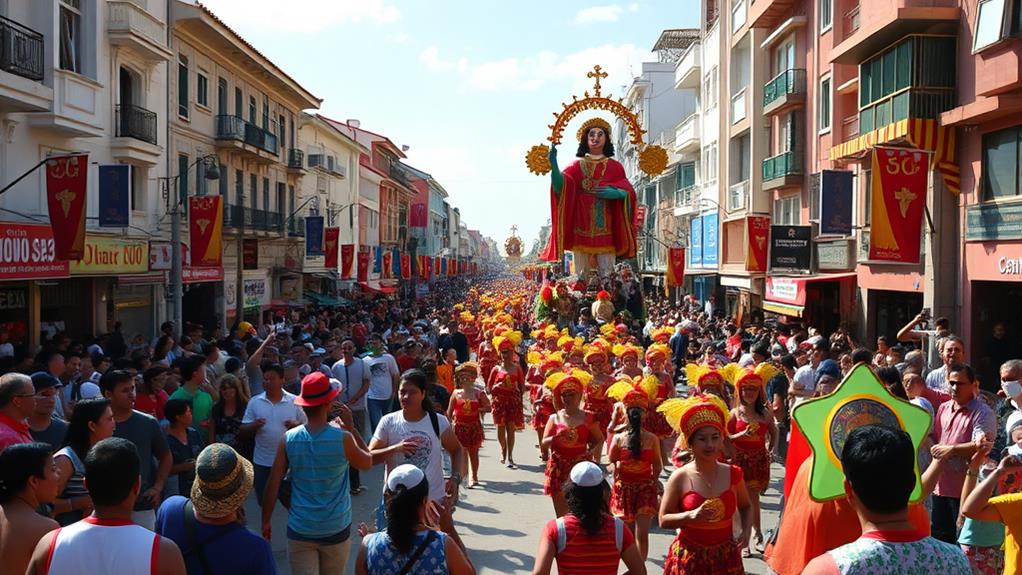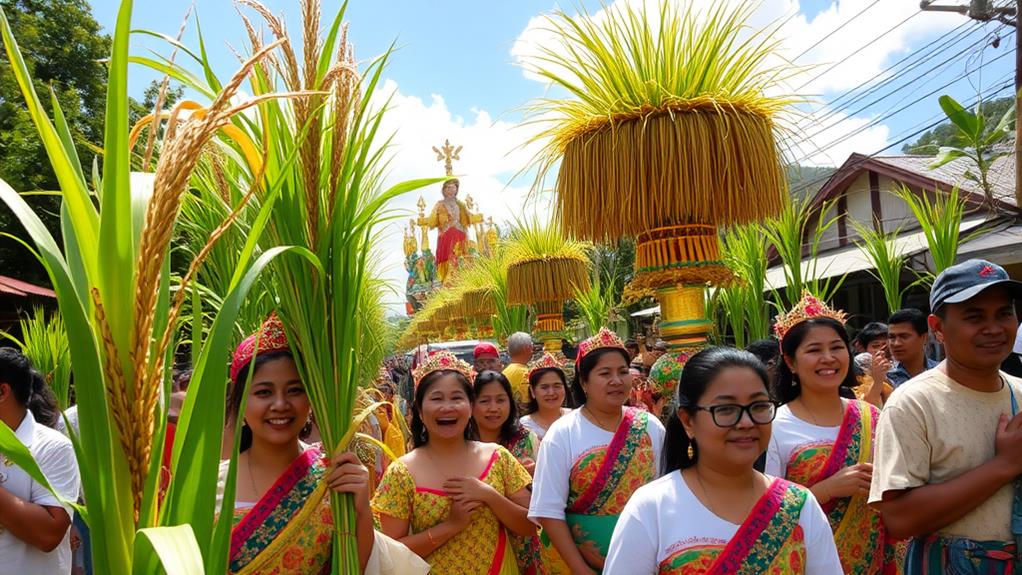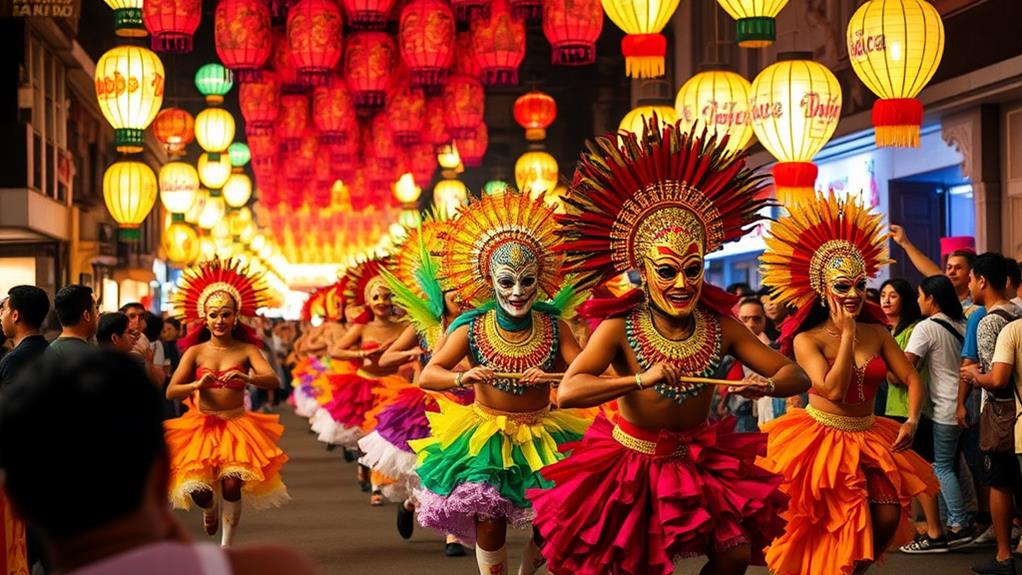The Philippines hosts over 100 festivals every year, showcasing its rich cultural heritage.
Some of the most notable ones include the Sinulog Festival, Panagbenga Flower Festival, Pahiyas Harvest Festival, Ati-Atihan Festival, and MassKara Festival. These events offer a glimpse into the country's traditions and celebrations.
The Sinulog Festival, for example, is a grand display of Filipino culture, while the Panagbenga Flower Festival showcases vibrant blooms.
The Pahiyas Harvest Festival, on the other hand, highlights the country's gastronomic delights.
Sinulog Festival Celebrations

The Sinulog Festival is an annual celebration held on the third Sunday of January in Cebu City, Philippines. This event attracts over 1 million visitors worldwide. The festival honors the Santo Niño (Child Jesus) and showcases the city's rich heritage and its transition to Christianity.
The Grand Parade is the festival's main highlight. The parade features vibrant floats and street dancers performing the traditional Sinulog dance. This dance mimics the movement of water currents. The parade culminates at the Cebu City Sports Complex, where participants and spectators gather for a lively celebration filled with music and dance.
Throughout the festival, visitors can experience cultural presentations, historical plays, and street parties that showcase Cebu's heritage.
Some examples of these cultural events include performances by local school groups and historical reenactments of the arrival of Spanish conquistadors. With its rich cultural significance and infectious energy, the Sinulog Festival is an unforgettable experience that leaves a lasting impression on its visitors.
Panagbenga Flower Festival
The Panagbenga Flower Festival is a vibrant celebration held every February in Baguio City. This annual event is a testament to the city's resilience and recovery from the 1990 Luzon earthquake.
The festival's name, Panagbenga, translates to "season of blooming" in the Kankanaey dialect, reflecting the city's rich cultural heritage. The grand float parade features elaborately decorated flower floats showcasing the city's artistic expression.
Street dancing competitions also take place, highlighting the local dancers' skills and cultural traditions.
The festival attracts thousands of tourists to Baguio City, promoting local artisans and businesses. Notable locations like Burnham Park and Session Road are transformed with colorful displays, contributing to the community's economic growth.
The Panagbenga Flower Festival is a celebration of nature and art, showcasing the beauty of Baguio City and its people.
This event is a must-attend celebration that will leave visitors in awe of the Philippines' natural beauty and artistic expression.
Pahiyas Harvest Festival

The Pahiyas Harvest Festival takes place annually on May 15 in Lucban, Quezon, to honor San Isidro Labrador, the patron saint of farmers.
The festival is a celebration of gratitude and abundance, showcasing the town's vibrant culture and rich heritage. The celebration begins with homes decorated with rice wafers, fruits, and handicrafts, creating a stunning display of the town's agricultural abundance.
Locals participate in a parade wearing traditional costumes and decorated floats, adding to the festive atmosphere.
The festival route changes annually to encourage diverse participation and promote local products. The festival features an array of local delicacies and street food, allowing visitors to savor the unique flavors of the region.
The town transforms into a vibrant display of agricultural abundance, with an emphasis on showcasing the region's cultural heritage through music and dance.
As part of the festival, local products are showcased alongside handicrafts and souvenirs, providing an opportunity for visitors to experience the region's unique traditions and customs.
The warm hospitality of the locals is an integral part of the festival, making visitors feel welcome and included in the celebrations.
The Pahiyas Harvest Festival is a must-attend event for anyone looking to experience the best of the Philippines' colorful festivals. With its stunning displays of agricultural abundance and rich cultural heritage, the festival offers a unique and unforgettable experience.
Ati-Atihan Festival Traditions
The Ati-Atihan Festival, celebrated every January in Kalibo, Aklan, is a tribute to the Santo Niño and a celebration of the indigenous Ati people and their early Malay settlers. Participants paint their faces with black soot as a sign of respect to the Ati people. This tradition is a unique aspect of the festival.
The streets of Kalibo come alive with the rhythmic beat of drums and vibrant street dancing during the festival. Participants chant "Viva! Santo Niño!" and "Hala Bira!" while adorned in colorful costumes and traditional attire.
The festival's grand parade showcases the rich heritage of Filipino culture with elaborate floats and cultural presentations.
The Ati-Atihan Festival is more than just a celebration – it's an experience that will leave you with a deeper appreciation for the country's history and traditions.
Joining in the vibrant street parties allows you to feel the energy and excitement of this world-renowned festival, recognized as the "Mother of Philippine Festivals."
Dinagyang Festival Highlights

The Dinagyang Festival is a significant celebration in Iloilo City, Philippines, held on the 4th Sunday of January in honor of the Santo Niño. This annual event showcases the rich cultural heritage of the region through its grand parade and various cultural presentations. It attracts thousands of tourists who come to witness the vibrant streets of Iloilo City.
Dinagyang incorporates a historical narrative of the barter trade between Malay settlers and the native Ati people, reflecting the area's history and traditions. This narrative is reenacted through a fluvial procession, featuring colorful boats that enhance the festive atmosphere.
The festival's highlight is the Ati-Atihan dance contest, where participants display their elaborate choreography and creative costumes to compete for the top prize.
The Dinagyang Festival is a unique blend of history, culture, and entertainment. It's an experience that leaves a lasting impression of Iloilo City's vibrant spirit.
Kadayawan Festival Experience
What is the Kadayawan Festival?
The Kadayawan Festival is a celebration that brings together the rich cultural heritage of Mindanao's indigenous peoples. It's held in Davao City during the third week of August.
What are the festival's highlights?
One of the festival's main highlights is the Indak-Indak sa Kadalanan, a street dance parade that showcases traditional dances and elaborate costumes representing different tribes.
Another highlight is the floral float parade, which displays intricate arrangements adorned with local flowers, fruits, and vegetables, highlighting the region's bountiful harvest.
What does the Kadayawan Festival represent?
The Kadayawan Festival is a symbol of unity and cooperation among the indigenous peoples of Mindanao. It also celebrates the unique traditions, cuisine, and artistry of Davao City.
What can you expect during the festival?
During the festival, you can expect to be part of a lively and festive atmosphere with thousands of local and international tourists in attendance.
You'll have the opportunity to explore the festival grounds and discover the unique traditions and culture of Davao City, creating unforgettable memories.
MassKara Festival Revelry

The MassKara Festival is a grand celebration held every October in Bacolod, Philippines.
The festival transforms the city into a vibrant spectacle of colors and rhythms. It features masked dancers wearing bright, smiling masks made from coconut husks and paper mache. The streets are filled with the sound of lively street parties, music concerts, and dance competitions.
The grand parade is a highlight of the festival.
Participants show off their colorful costumes and elaborate headdresses, adding to the festive atmosphere. The parade is an important part of the celebration, as it brings people together and fosters a sense of community.
The MassKara Festival is a community-driven event.
It promotes a sense of belonging and joy among the participants and spectators alike. The festival culminates in a street dance competition, where groups perform intricate routines to lively music. Their costumes showcase Bacolod's rich culture and heritage.
The unique blend of revelry and community spirit makes the MassKara Festival unforgettable.
The festival leaves a lasting impression on those who experience it, making it a must-visit event for anyone looking to immerse themselves in the rich culture of Bacolod.
Higantes Festival Parade
The Higantes Festival Parade takes place in Angono, Rizal, on November 23, in honor of its patron saint, San Clemente.
The festival features vibrant parades with colorful costumes and giant papier-mâché figures. The streets come alive with the town's artistic talent and community spirit. This celebration showcases the town's passion for art, community, and cultural heritage.
Key highlights of the festival include:
- Giant figures, called "Higantes," that tower above the crowds, showcasing local artistry and creativity. These figures demonstrate the town's artistic talent and are a major part of the festival.
- Vibrant costumes that add to the festival's kaleidoscope of colors and textures. Locals wear these costumes to participate in the parade and showcase their creativity.
- Locals opening their homes to visitors, offering a unique glimpse into Angono's rich culture and hospitality. This tradition allows visitors to experience the town's culture firsthand.
- The festival's evolution from a playful mockery against oppressive landlords to a significant cultural celebration. The festival has transformed over time to become a celebration of the town's heritage.
- Thousands of visitors from around the world gathering to experience the Higantes Festival's magic. The festival attracts a large and diverse crowd.
The Higantes Festival Parade is an unforgettable experience. It showcases the town's passion for art, community, and cultural heritage through its giant figures, colorful costumes, and infectious energy.
What Makes These Festivals in the Philippines Must-Attend Events?
The vibrant and colorful celebrations of Filipino festivals throughout the year make them must-attend events. From the lively Ati-Atihan Festival to the grand Sinulog Festival, each event showcases the rich cultural heritage of the Philippines. With traditional dances, parades, and delicious food, these festivals offer a unique and unforgettable experience.
Moriones Festival Reenactments

The Moriones Festival: A Unique Cultural Experience
The Moriones Festival, held in Marinduque during Holy Week, is a unique cultural experience that showcases the country's rich heritage through a reenactment of biblical stories related to the Passion of Christ.
Key Elements of the Festival
The festival features several key elements that make it a standout cultural experience. Colorful masks and costumes are worn by participants, known as "Moriones," who portray Roman soldiers. These masks and costumes are elaborate and embody the characters of the story.
Reenactments and Processions
The festival's highlight is the dramatic portrayal of Longinus, a blind centurion who was said to have pierced Jesus' side. This reenactment is part of a series of theatrical portrayals of biblical stories that take place throughout the festival.
A grand procession showcases both theatrical and religious elements, making it a unique blend of artistry and devotion.
Themes and Reflection
The Moriones Festival is a celebration that encourages reflection on faith and devotion. Themes of penitence and devotion are woven throughout the festival, making it a deeply spiritual event.
This celebration is a chance to experience the Philippines' unique expression of faith and culture.
A Cultural Experience
The Moriones Festival attracts thousands of locals and tourists who come to witness the reenactments and festivities.
A unique blend of religion, history, and artistry makes this festival a standout cultural experience that showcases the country's rich heritage.
Obando Fertility Rites Celebration
The Obando Fertility Rites Celebration is an annual festival in the Philippines that takes place from May 17 to 19. This event honors three saints: San Pascual Baylon, Sta. Clara, and the Virgin Mary.
The celebration features vibrant street dances that showcase the community's energy and creativity. These dances are characterized by participants wearing traditional attire and dancing to folk music.
The event also includes colorful processions, where participants make offerings and seek blessings for fertility and family well-being.
The main purpose of the Obando Fertility Rites Celebration is to seek blessings for fertility and family. Couples and families participate in this event to pray for a good harvest, healthy children, and overall well-being.
The celebration is a unique blend of religious devotion and community involvement.
The Obando Fertility Rites Celebration is a culturally significant event that highlights the community's deep-rooted beliefs and values surrounding fertility and family.
This event attracts locals and tourists alike, showcasing the Philippines' rich cultural heritage and warm hospitality.
Questions and Answers
What Is the Importance of Celebrating Festivals in the Philippines?
Celebrating festivals is crucial in the Philippines as it plays a significant role in preserving the country's vibrant cultural heritage. Festivals foster community bonding by bringing people together, regardless of their social status or background. For instance, the MassKara Festival in Bacolod City showcases the city's resilience and unity through street dancing and colorful costumes.
Festivals also drive economic impact by attracting tourists and generating revenue for local businesses. The Sinulog Festival in Cebu City, for example, draws millions of visitors each year, boosting the local economy through hotel bookings, food sales, and souvenir purchases.
Moreover, festivals showcase artistic expression through music, dance, and art. The Panagbenga Festival in Baguio City features elaborate flower arrangements and floats, highlighting the city's creativity and artistry.
Lastly, festivals highlight historical significance, allowing Filipinos to honor their heritage and cultural traditions. The Fiesta de Santo Niño in Cebu City, for instance, commemorates the arrival of Spanish conquistadors in the Philippines and the introduction of Christianity.
What Is the Top 1 Festival in the Philippines?
The Sinulog Festival is the top festival in the Philippines. This festival is considered the largest and most culturally significant in the country, surpassing other notable festivals like the Ati-Atihan, Pahiyas, Panagbenga, Kadayawan, Obando Fertility Rites, and Malasimbo.
What Is the Most Unique Festival in the Philippines?
The most unique festival in the Philippines is Pahiyas. This annual celebration, held in Lucban, Quezon, is a vibrant display of Filipino culture and tradition. It features colorful parades, traditional dances, and local cuisines, showcasing the community's rich heritage. A distinctive aspect of Pahiyas is the decoration of houses with intricate designs made from rice wafers, fruits, and vegetables, highlighting the town's agricultural abundance.
What Is the Biggest Religious Festival in the Philippines?
The Sinulog Festival is the Philippines' biggest religious celebration. It is a significant event that highlights the country's vibrant faith and culture. Two other notable festivals, Ati-Atihan and Flores de Mayo, also showcase the Philippines' rich cultural heritage.